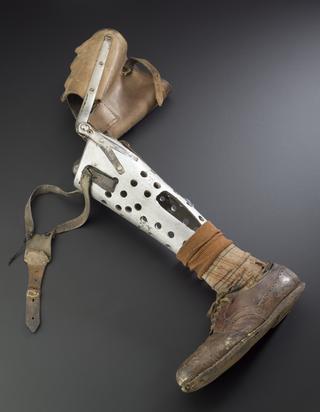

Left below elbow arm, leather socket, suspended by means of a narrow leather upper-arm band. Oval wrist with screw-on wooden hand, articulated fingers and tenon thumb. Palm-box fitting in which a fork has been positioned. It is presumed the wearer had limited elbow movement hence the unusual position of the fork. Date & origin unknown, probably 1930's but repaired more recently by Steepers.
Fixed to the palm of the hand, this fork was intended to help the wearer eat. It is possible that the wearer had limited elbow movement, after their arm was amputated below the joint, which is why the fork is fixed in an unusual position. The screw-on hand is fully articulated and has fingernails carved into the wood. The arm is secured to the wearer’s stump by the leather socket and arm band.
Although the original maker is unknown, the arm has undergone repairs by Steepers, an American limb-making company based at Queen Mary’s Hospital in Roehampton, England. This institution was established in 1915 to deal with the growing number of amputees returning from fighting in the First World War. Initially, mainly American limb makers were employed as they were better able to meet the unprecedented demands.
Details
- Category:
- Orthopaedics
- Object Number:
- 1999-604
- Measurements:
-
overall: 112 mm x 510 mm x 120 mm, .69kg
- type:
- artificial arm
- credit:
- Richmond Twickenham and Roehampton Healthcare NHS Trust




